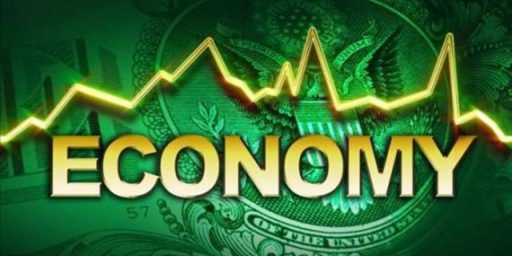Third Quarter GDP Grew 3.9% According To Latest Estimate
With all the news about Ferguson and other commitments, I missed the news that economic growth in the 3rd Quarter had been revised significantly upward to 3.9% in the latest report from the Department of Commerce:
The nation’s economic output grew at an even faster rate during July, August and September than the government initially estimated, giving the economy its strongest six-month performance in more than a decade.
The intense focus on the coming shopping frenzy as the holiday period begins this week almost made interest in the economy’s third-quarter performance seem like an exercise in nostalgia. But the Commerce Department’s release on Tuesday of its revised estimate of gross domestic product — the broadest measure of goods and services produced across the nation — showed that consumers had already stepped up their pace of purchasing.
The shift in the annual rate of growth to 3.9 percent from 3.5 percent was mainly because of a bigger-than-expected jump in consumer spending, bolstered by a modest increase in reported business investment.
The upward revision was almost exclusively due to much stronger buying by consumers,” said Carl R. Tannenbaum, chief economist at the Northern Trust Company. “I find that very encouraging coming into the commercial side of the holiday seasons.”
While the economic recovery, now into its sixth year, has been lackluster, Mr. Tannenbaum noted that in four of the last five quarters, “growth has moved to a much stronger level.” This 3.9 percent growth rate comes on the heels of a 4.6 percent jump inG.D.P. during the second quarter, after a freezing winter that helped cause the nation’s output to drop at a rate of 2.1 percent in the first three months of the year.
Ian Shepherdson, chief economist at Pantheon Macroeconomics, agreed that “the trend has shifted higher,” although he said he doubted that G.D.P. growth could be sustained at the third quarter’s nearly 4 percent pace.
Falling gasoline prices, which left Americans with more cash for other purchases, partly explain why people could spend more, economists agree.
The G.D.P. figures made the drop in the Conference Board’s latest measure of consumer confidence to 88.7 in November from 94.1 in October all the more of an anomaly. Other surveys, including the Rasmussen index, have shown confidence surging.
Consumer spending is a closely watched figure because it accounts for 70 percent of economic activity and must advance at a steady rate to power the economy forward.
But it is business investment, including the rise and fall of inventory accumulation, that most influences economic turning points. Nonresidential investments grew by 7.1 percent, while investment in equipment reached 10.7 percent.
All in all a good report headed into the 4th Quarter, which for many businesses is the most important quarter of the year, and an indication that while economies in Europe and China continue to languish to some degree, the U.S. economic engine is going fairly strongly.



So the stimulus did work…
OK, conservatives aren’t going to believe that, like creationists aren’t going to believe in an old earth, but I’d be interested to know what is the conservative explanation for why the US economy is doing so well compared to say, Europe.
@stonetools:
I’d say Qualitative Easing did more than the stimulus, especially to avoid the 2nd and 3rd recessions which Europe and Japan had. Of course, nearly everyone who opposed the stimulus opposed QE.
@Moosebreath:
Indeed, Doug doesn’t believe QE, either. Conservative economists swore it would lead to runaway inflation. Wrong again, Bob.
Read this entertaining Noah Smith essay how conservative economists of the Austrian School were proven wrong on QE:
RDWT for some yuks.
@stonetools:
Also…the Republican forced austerity/economic sabotage, while a massive drag on the economy here, is no where as deep as in Europe.
As resilient as our economy has shown itself to be….imagine how much suffering and pain could have been avoided if Republicans were as interested in governing as they are in simply winning elections. They are the single reason we were not here, economically speaking, 2-3 years ago.
Republican Response 1: “if only we let the Auto Industry go bankrupt back in 2009, imagine how much more growth we would be experiencing.”
Republican Response 2: “the Department of Commerce is cooking the books, we need to investigate this.”
Republican Response 3: “more evidence that the ongoing fiscal stimulus and Fed’s QE is an abject failure. Socialist economic policies always fail.”
The country voted to reward this performance by giving the GOPs a majority in the Senate and a bigger majority in the House, proving once again that the electorate are a box of rocks.